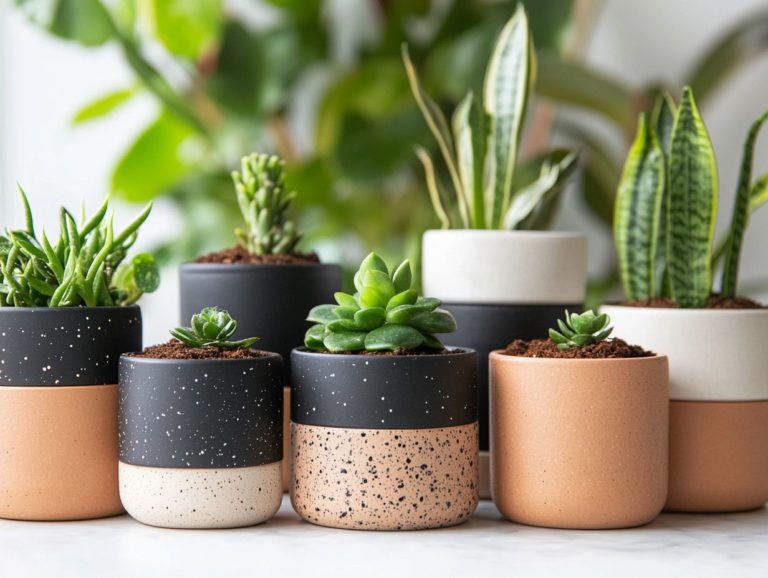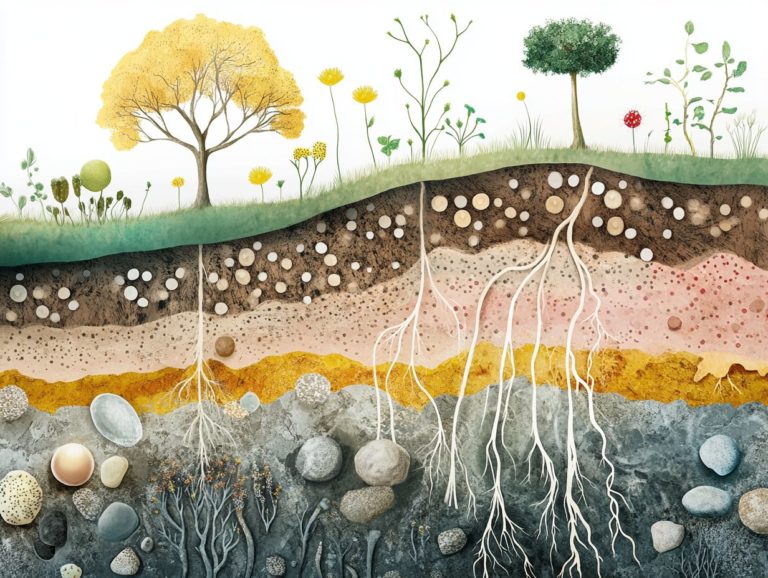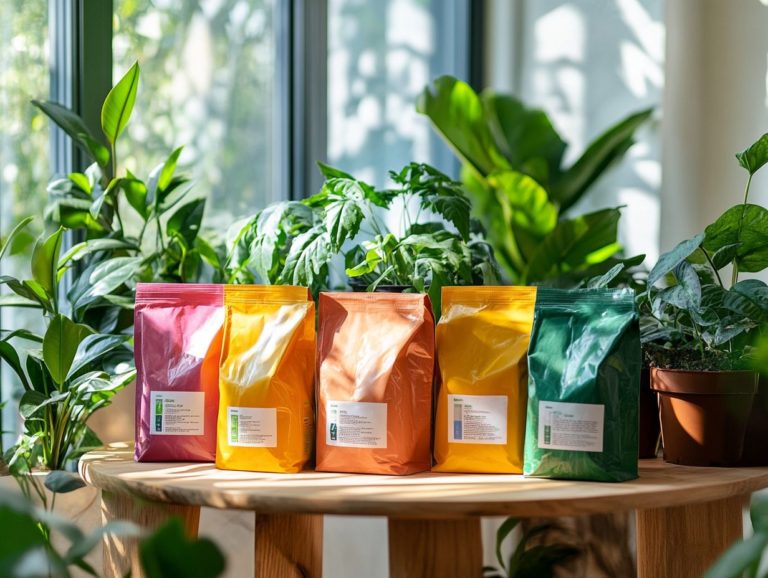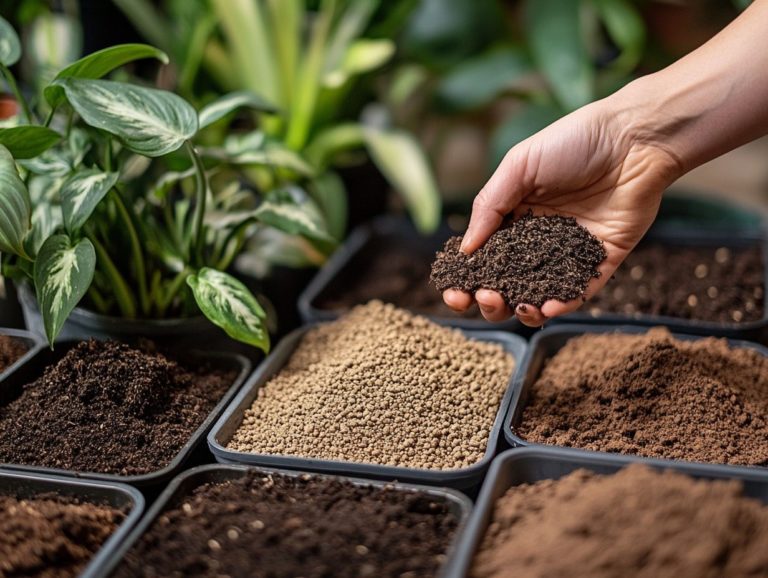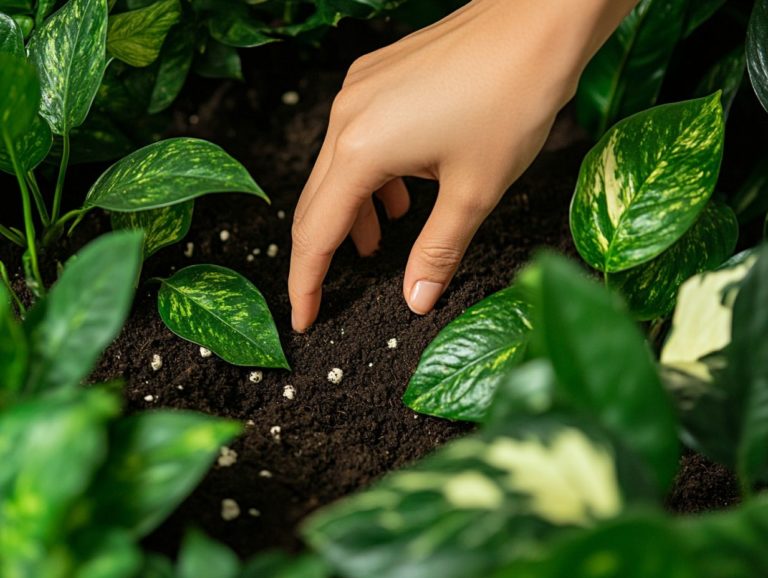Best Soil Choices for Specific Indoor Plants
Choosing the perfect soil is crucial for your plants health and happiness! Each plant has unique needs that can greatly impact its growth.
This guide covers the best soil options for various indoor plants, from succulents to orchids!
Whether you’re a gardening pro or just starting, you’ll find valuable tips to create the ultimate environment for your plant pals.
Contents
- Key Takeaways:
- 1. Choosing the Right Soil for Your Indoor Plants
- 2. Best Soil Choices for Succulents
- 3. Best Soil Choices for Ferns
- 4. Best Soil Choices for Orchids
- 5. Best Soil Choices for Cacti
- 6. Best Soil Choices for Herbs
- 7. Best Soil Choices for Tropical Plants
- 8. Best Soil Choices for Air Plants
- 9. Best Soil Choices for Flowering Plants
- 10. Best Soil Choices for Foliage Plants
- Why Is Choosing the Right Soil Important?
- What Factors Should You Consider When Choosing Soil?
- What Are the Different Types of Soil?
- Best Practices for Mixing Your Own Potting Soil
- 12. Monitoring Soil Health
- 13. Repotting Plants: When and Why
- 14. Watering Tips for Different Soil Types
- 15. Addressing Common Soil-Related Issues
- 16. Environmental Impact of Soil Choices
- 17. Cost-Effective Soil Options
- 18. The Role of Organic Matter in Soil Health
- 19. Soil Amendments: Enhancing Soil Quality
- 20. Top Soil Brands to Consider
- 21. Understanding Soil Texture and Its Importance
- 22. The Importance of Soil Testing
- 23. Seasonal Soil Care Tips
- 24. Soil for Container Gardening
- 25. Common Myths About Potting Soil
- 26. The Future of Soil and Gardening
- 27. Using Technology for Soil Management
- 28. Soil Conservation Practices
- 29. The Role of Soil in Plant Nutrition
- 30. Integrating Soil Health into Your Gardening Routine
- 31. Soil Mycorrhizae: Enhancing Soil Fertility
- 32. The Importance of Soil Microorganisms
- 33. Soil Erosion: Causes and Solutions
- 34. The Benefits of Mulching for Soil Health
- 35. The Influence of Soil Temperature on Plant Growth
- 36. The Impact of Soil Compaction
- 37. Adapting Soil Practices for Climate Change
- Frequently Asked Questions
- What are the best soil choices for specific indoor plants?
- What type of soil is best for succulents and cacti?
- What is the best soil choice for ferns and other humidity-loving plants?
- Can I use regular garden soil for indoor plants?
- What is the best soil for orchids?
- How often should I repot my indoor plants?
Key Takeaways:

- Choose the best soil for your indoor plants based on their specific needs.
- Succulents thrive in well-draining soil that is low in nutrients, which can be achieved by creating a custom soil mix.
- Ferns prefer rich, well-draining soil that retains moisture. Avoid using overly compacted or dry soil for them.
1. Choosing the Right Soil for Your Indoor Plants
Choosing the right soil is crucial for your plants’ health. The ideal soil provides the right nutrients, retains moisture, and offers proper drainage tailored to your houseplants needs.
Understanding the differences between potting mixes and specialized blends like cactus mix or succulent mix can elevate your indoor gardening success.
Each plant species has unique requirements that dictate the perfect soil composition. This influences important factors like aeration, pH levels, and moisture retention all vital for keeping your plants healthy.
Your soil choice directly affects water drainage, helping to prevent root rot a common problem for indoor gardeners. An all-purpose potting mix usually retains moisture while allowing for good ventilation, making it ideal for leafy houseplants.
Specialized blends for orchids or succulents have a coarser texture that facilitates rapid drainage and supports their distinct watering needs.
By selecting the right potting medium, you can enhance nutrient availability and ensure your plants not only survive but thrive, transforming your space into a lush indoor oasis.
2. Best Soil Choices for Succulents
For succulents, the right soil is a must. These remarkable plants flourish best in conditions that mimic their natural habitats, so you’ll want a well-draining potting mix designed specifically for them.
Succulents have adapted to arid environments, so excellent drainage is essential for their well-being. To achieve the perfect soil composition, consider a mixture of perlite for aeration, peat moss for slight moisture retention, and vermiculite to boost drainage.
This combination allows air to circulate freely while preventing water from pooling around the roots, which could lead to rot. If you’re ready for a fun DIY project, crafting your own succulent soil mix is a breeze! Just blend equal parts of these components, and you’ll create a mix that caters perfectly to their needs, fostering healthy growth and vitality.
3. Best Soil Choices for Ferns
Ferns have unique preferences when it comes to growing conditions. If you’re aiming for lush, leafy plants, ensure the soil is rich in organic matter. It should also maintain moisture levels without becoming waterlogged. This balance is crucial for their health and growth.
This specific equilibrium is vital. Ferns naturally flourish in environments characterized by consistent humidity and well-draining conditions. To craft the perfect soil blend, think about incorporating components like coconut coir, which helps retain moisture, alongside vermiculite to improve aeration. This combination allows the roots to breathe while keeping them comfortably moist.
Avoid these common mistakes for thriving ferns! Many homeowners rely on standard potting mixes that fail to provide adequate drainage. This can lead to soggy roots and potential rot. Sidestepping these pitfalls is essential to ensure healthy growth for various fern species and to avoid health issues associated with improper soil quality.
4. Best Soil Choices for Orchids
Orchids demand specialized care. Standard potting mix won t work for orchids; you need a blend that promotes air circulation in the soil and mimics their natural habitat to support robust root growth. The ideal potting medium for orchids prioritizes excellent drainage while ensuring adequate moisture levels.
Air circulation is crucial for their roots. Orchids naturally thrive in trees, basking in the airflow that surrounds them and benefiting from optimal soil aeration. To create the perfect growing environment, consider various potting materials.
- Use coarse bark for air pockets.
- Incorporate sphagnum moss, which retains moisture without suffocating the roots.
- If you’re seeking a lightweight alternative, try Hydrafiber, which combines water retention and air drainage beautifully.
By mixing these materials in the right ratios, you can craft a custom soil blend tailored to the unique needs of your orchids. This sets the stage for vibrant and healthy blooms that will leave you in awe!
5. Best Soil Choices for Cacti
Cacti, those marvelous survivors of arid landscapes, flourish best in soil meticulously designed for optimal drainage. Choosing the right soil for your cacti is key to their health. The ideal soil choices include specialized potting mixes that guard against root rot while accommodating their distinct watering needs.
A blend featuring sandy soil mixed with perlite, lava rock, or pumice creates an ideal environment. This ensures proper aeration and water flow for healthy cacti. Different species may have their own preferences, so it s wise to adjust accordingly. Some might favor a coarser mix or a custom soil blend that meets their unique needs.
Common pitfalls, like using heavy garden soil or overly compacted mixtures, can wreak havoc on their root systems, ultimately stunting their vitality.
6. Best Soil Choices for Herbs
In herb gardening, selecting the right soil is paramount for achieving nutrient-rich growth and robust flavor. A nutrient-rich potting mix can significantly elevate the growth and flavor of your herbs, providing the perfect balance of essential nutrients, aeration, and moisture retention essential for healthy plants.
Herbs have unique soil preferences. Some thrive in well-drained sandy soils, while others favor heavier, moisture-retaining loams. Generally, a mix that includes organic matter, such as compost, enriches the soil with vital nutrients like nitrogen, phosphorus, and potassium.
Don t overlook the importance of drainage. Herbs like basil and oregano thrive in soils that allow excess water to escape, preventing root rot. In contrast, parsley and cilantro can tolerate a bit more moisture.
To create the ideal blend for robust growth, combine equal parts of loamy soil, peat moss, and perlite. This winning mix promotes strong roots and lush growth! Set the stage for a flourishing herb garden rich in plant nutrition.
7. Best Soil Choices for Tropical Plants
Tropical plants thrive in environments that closely mirror their natural habitats. When selecting soil, opt for a blend rich in organic matter that maintains consistent moisture levels tailored to your plants’ specific needs, enhancing their overall health and growth.
To cultivate a flourishing tropical garden, craft a potting mix that balances drainage with moisture retention. A combination of peat moss, coconut coir, and well-rotted compost provides excellent organic matter, delivering diverse nutrients that tropical species crave.
Incorporating perlite or vermiculite into your mix enhances aeration and prevents waterlogging, which can lead to root rot. By avoiding overly dense or compacted soils, you create the balanced environment your tropical plants need for robust growth and vibrant foliage.
8. Best Soil Choices for Air Plants
Air plants, also known as plants that grow on other plants without soil, don t rely on traditional soil for growth. However, using the right soil alternatives or potting mixes offers the support and aeration they need for optimal growth conditions.
These fascinating plants absorb moisture and nutrients through their leaves, bypassing the need for roots. To create the perfect environment, consider using hydrafiber a lightweight, breathable material that promotes airflow or specialized substrates tailored for air plants, available at your local garden center.
Choose the appropriate medium for your indoor plants and remember to mist them regularly or soak them in water every couple of weeks. This keeps them hydrated while preventing stagnant standing water. Ensure they receive bright, indirect light to greatly contribute to their overall health and vitality.
9. Best Soil Choices for Flowering Plants
Choosing the right soil opens the door to stunning blooms! A nutrient-rich potting mix is essential for providing the necessary elements that promote robust plant nutrition and overall health.
A rich blend of organic matter, such as compost, boosts soil fertility and encourages beneficial microbial activity, vital for optimal nutrient absorption. Prioritize specific nutrients like phosphorus to enhance blooming and potassium for strong root growth.
Craft the perfect mix for your flowering species by combining equal parts of loamy soil, organic compost, and a well-draining component like coconut fiber. Test the soil pH levels to create an ideal environment for those magnificent blooms to flourish!
10. Best Soil Choices for Foliage Plants
Foliage plants often demand specific potting mediums for optimal growth. To select the best soil, understand their moisture level requirements and choose potting mixes that support their lush foliage and vibrant leaves.
Different foliage plants flourish in various soil types, reflecting their native habitats. For instance, tropical varieties thrive in well-aerated, moisture-retaining mixes that incorporate peat moss and perlite to enhance drainage while maintaining essential water retention.
Succulent and cactus enthusiasts should opt for sandy soil or fast-draining potting soil to prevent root rot. When crafting or selecting a potting mix, consider nutrient availability; adding elements like compost or organic fertilizers can significantly impact your plants’ health.
By customizing the soil composition to meet the specific needs of each plant, you create a thriving indoor gardening space brimming with lush greenery!
Why Is Choosing the Right Soil Important?
Choosing the right soil is essential for ensuring that your plants receive the proper nutrients and support they need for robust growth. The ideal soil provides excellent drainage, retains moisture, and delivers the essential nutrients tailored to each plant’s specific needs.
Soil quality is crucial for root development and overall plant vitality. When roots are healthy, they can access water and nutrients more efficiently, resulting in vigorous growth and greater resilience against health issues and diseases.
Different plants thrive in various potting mediums, making your soil selection critical. For example, succulents flourish in well-draining soil to prevent root rot, while tropical plants thrive in a moisture-retaining mix that helps maintain humidity levels.
By grasping these distinctions, you can cultivate a nurturing environment that fosters long-term health and vibrant foliage, ultimately enhancing your experience of plant care.
What Factors Should You Consider When Choosing Soil?

When selecting soil for your plants, consider several critical factors, including the level of acidity or alkalinity in the soil, moisture levels, and the specific needs of your plant habitats. These elements are crucial for determining how well your plants can thrive, especially in varying growing conditions.
The pH of the soil directly influences nutrient availability, affecting how effectively your plants can absorb essential minerals. Nutrient content is equally important, as different plants have varying requirements for nitrogen, phosphorus, and potassium. For example, while some flowering plants thrive in sandy, well-drained soil, others might prefer a richer, loamy mix that includes a material that helps retain water for water retention.
To create the perfect environment for growth, it s wise to conduct a soil test to evaluate these characteristics. This knowledge enables you to make informed decisions that align perfectly with the specific conditions your plants require.
What Are the Different Types of Soil?
Understanding the different types of soil available is crucial for effective plant care. Each type be it potting mixes, cactus mixes, or sandy soils boasts unique characteristics tailored to meet diverse plant needs and growth conditions.
By recognizing the specific attributes of these soils, you can better cater to the requirements of your green companions, ensuring they flourish in their environments. For example, potting mixes generally supply the essential nutrients and moisture retention necessary for indoor plants, while cactus mixes are crafted for outstanding drainage for those desert-loving species. To ensure the best care, it’s also important to consider choosing the right water for indoor plants. Meanwhile, sandy soils are perfect for certain outdoor plants that thrive in drier conditions.
Choosing the right soil type doesn’t just promote healthy growth; it also elevates the overall aesthetic of your indoor or outdoor garden. Therefore, it’s vital to consider the specific growth conditions each plant demands, including understanding soil pH for indoor plants, to create a thriving green space.
Best Practices for Mixing Your Own Potting Soil
Mixing your own potting soil can be an incredibly rewarding endeavor. By understanding the right soil ingredients and their ideal ratios, you can create a custom potting mix tailored precisely to your plants’ nutritional needs and growing conditions.
This bespoke blend guarantees that your plants receive optimal drainage, soil aeration, and moisture retention essential elements for robust growth. Start gathering these ingredients today for your custom potting mix!
Here are the key components needed for an effective potting mix:
- Peat moss and coco coir, which retain moisture while providing a slightly acidic environment.
- Perlite, celebrated for its lightweight nature and excellent drainage capabilities, is a key component for potting mixes.
- Vermiculite, known for its ability to hold moisture and make nutrients readily available, will enhance your water retention in the mix.
Each of these components plays a unique role in crafting the perfect potting mix. Mix equal parts of each ingredient: one part peat moss, one part perlite, and one part vermiculite for the best results. This balanced approach will effectively support your plants’ health and vitality, including succulent mixes and cactus mixes.
12. Monitoring Soil Health
Monitoring soil health is essential for nurturing vibrant plants. By utilizing a soil test kit, you can assess soil pH levels, nutrient content, and moisture levels, ensuring your plants receive the optimal care they deserve.
Regularly testing the soil grants you valuable insights into the conditions impacting plant growth. Each test kit typically comes with clear instructions, enabling you to understand the specific needs of your plants.
Once you have the results, interpreting them correctly is crucial. For instance, a low soil pH may call for amendments like lime to restore balance. Deficiencies in key nutrients can be addressed through the addition of organic fertilizers to enhance plant nutrition.
By making these adjustments, you create a healthier environment that fosters robust plant development. This allows your garden to thrive for the long haul with healthy plants.
13. Repotting Plants: When and Why
Repotting your plants is a vital part of plant care that can truly elevate root growth and overall health. Understanding when and why to repot will enhance your indoor gardening experience significantly.
You ll find there are several telltale signs that it s time to tackle this essential task. One major indicator is when the roots start growing in circles around the base of the pot a situation known as being root-bound.
If you notice your plant exhibiting stunted growth or drying out faster than usual after watering, it s likely a sign that the soil quality has diminished. This means it is losing its nutrients and structure over time, which can impact overall houseplant health.
When you set out on your repotting journey, choosing the right potting mix is key. Look for a blend that caters to your plant s specific needs, ensuring it has proper drainage while still retaining enough moisture to foster healthy growth.
14. Watering Tips for Different Soil Types
Watering techniques vary significantly across different soil types, and understanding how each type retains moisture is key to developing effective watering tips that meet your plants’ unique needs.
For example, sandy soils drain quickly, which means they require more frequent watering. On the other hand, clay soils hold moisture for longer, so you ll need to irrigate them less often.
Recognizing these distinctions allows you to adjust your methods accordingly whether that means using drip irrigation for sandy soils or ensuring proper drainage in clay-heavy areas.
It s also crucial to monitor moisture levels. Some plants thrive in drier conditions while others prefer consistently moist soil. By observing your plants and checking the soil with your fingers, you can customize your watering schedule, ensuring each plant gets just the right amount of water without drowning the ground.
15. Addressing Common Soil-Related Issues
Common soil-related issues can have a profound impact on plant health, making it imperative to address problems such as root rot and poor drainage without delay. This proactive approach will ensure your plants not only survive but truly thrive.
Compacted or overly acidic soil stifles root development and nutrient absorption, presenting challenges even for the hardiest of plants. These unfavorable conditions are often worsened by factors like excessive rainfall, improper soil amendments, or poor site selection.
Take charge and tackle these issues by:
- Incorporating organic matter
- Practicing crop rotation
- Monitoring pH levels regularly
By understanding these common pitfalls and taking proactive measures, you can cultivate a healthier environment for your greenery. This fosters robust growth and enhances resilience against pests and diseases.
Don’t wait! Start improving your soil health today to see your plants flourish!
16. Environmental Impact of Soil Choices
The environmental impact of your soil choices is paramount in sustainable gardening practices. Selecting soil rich in organic matter significantly enhances your garden’s ecosystem.
This thoughtful selection improves soil structure and nurtures beneficial microbial activity, essential for nutrient cycling. A well-balanced mix of soil ingredients like compost and natural fertilizers creates a vibrant environment for your plants. This enhances water retention and minimizes the need for excessive irrigation.
It s crucial to understand how incorporating sustainable practices such as crop rotation and organic amendments can enrich soil health. By prioritizing organic components and reducing chemical inputs, you can cultivate a flourishing garden that aligns with the larger mission of environmental stewardship.
17. Cost-Effective Soil Options
You can find cost-effective soil options without sacrificing plant health. There are many affordable potting mixes that deliver outstanding quality and provide ample nutrients for various plant types.
To ensure the blends you choose support optimal growth, consider the specific needs of your plants. Pay attention to critical factors like drainage, pH levels, and moisture retention. Analyzing product labels reveals essential ingredients such as peat moss, compost, or perlite, which all contribute to a well-balanced mixture.
Don t overlook local garden centers or community gardening groups. They might introduce you to lesser-known brands that offer quality soil without causing a dent in your wallet. Comparing prices and reading reviews will help you find blends proven effective for others, making it easier to cultivate vibrant and healthy plants without overspending.
18. The Role of Organic Matter in Soil Health
Organic matter is a cornerstone of healthy soil. It enhances soil structure, boosts nutrient availability, and aids in moisture retention all essential for optimal plant nutrition.
This rich material acts as a haven for beneficial microorganisms, promoting plant health by facilitating nutrient cycling and decomposition. Incorporating organic materials in your garden or potted plants can significantly improve growth and resilience.
Consider integrating the following common examples into your soil care routine:
- Compost: Enriches the soil with a balanced array of nutrients.
- Aged bark or coconut coir: Enhances aeration and drainage.
Leaf litter and well-rotted manure add essential minerals and organic compounds, creating a thriving environment for root systems and supporting robust vegetative growth.
19. Soil Amendments: Enhancing Soil Quality
Soil amendments are crucial for elevating soil quality. By incorporating the right amendments into your potting soil, you can significantly enhance its texture, nutrient content, and overall fertility for your plants.
These improvements are essential for various plant types, whether you re nurturing vegetables, flowers, or shrubs. For example, perlite, a lightweight material, improves drainage and is perfect for succulents and other drought-tolerant species. In contrast, vermiculite retains moisture and nutrients, beneficial for plants thriving on consistent hydration.
Compost is a rich organic amendment. It not only enriches the soil with essential nutrients but also encourages beneficial microbial activity. By grasping the unique characteristics of these amendments and their specific applications, you can craft optimal growing conditions tailored to meet the distinct needs of your cherished plants.
20. Top Soil Brands to Consider
Choosing the right potting mix becomes effortless when you focus on reputable soil brands celebrated for their quality and effectiveness in promoting plant health.
Among these brands, Miracle-Gro stands out with its specially formulated potting mix that delivers essential nutrients for a wide variety of houseplants. If you’re leaning toward organic options, FoxFarm is an excellent choice, offering blends ideal for vegetable growers seeking a natural approach. For more insights, check out the top soil amendments for healthy indoor plants.
Then there’s Black Gold, featuring a versatile mix tailored for diverse plant types, whether you’re nurturing flowering plants or leafy greens. Each of these brands sets itself apart with unique formulations designed to meet specific botanical needs. This ensures you can effortlessly find the perfect soil solution for your thriving plants. Try these soil options today and watch your plants thrive!
21. Understanding Soil Texture and Its Importance
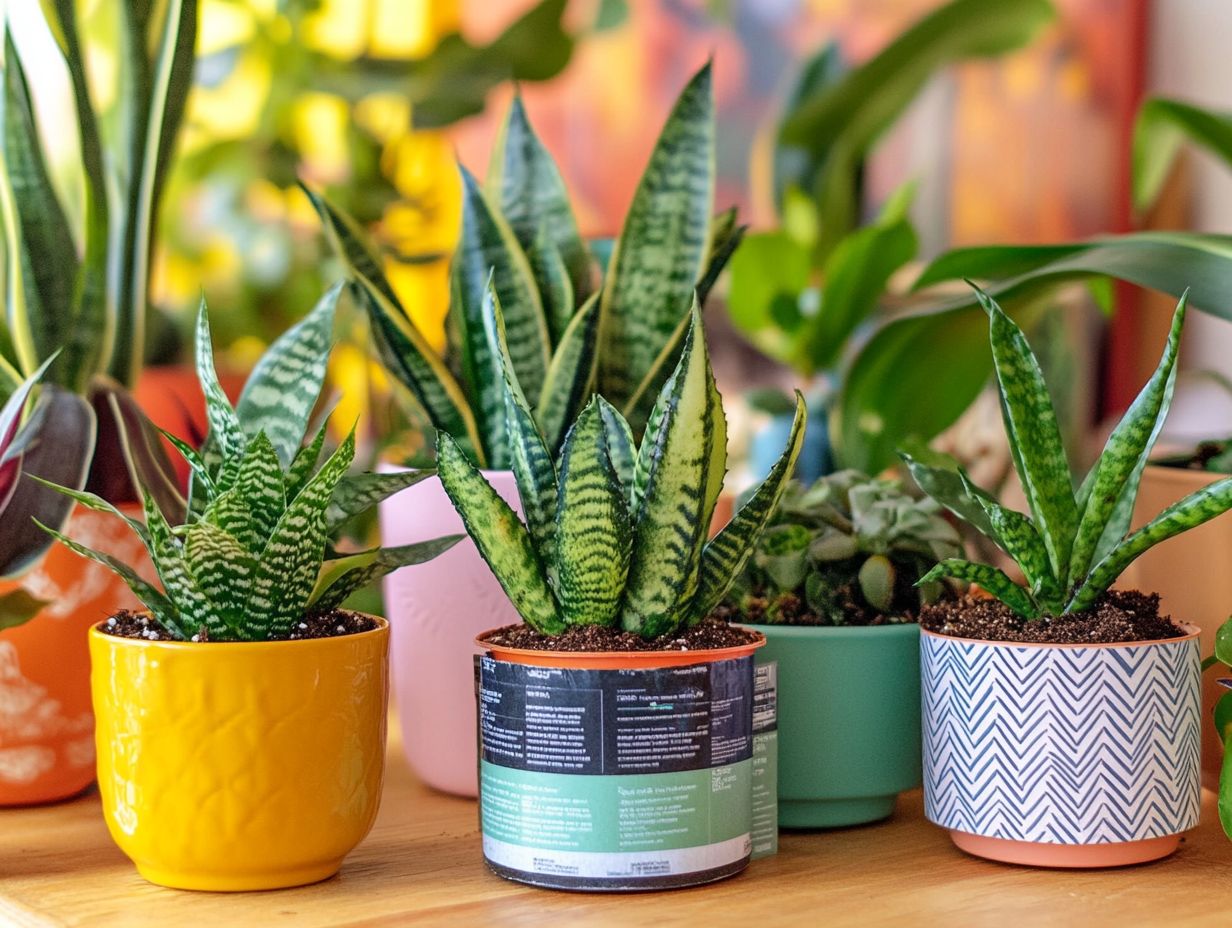
Soil texture plays a key role in your gardening success. It influences drainage, keeping nutrients, and root growth. It s essential to choose the right soil for your plants.
Each soil texture, from sandy to clayey, has its own advantages and challenges. Sandy soils offer quick drainage, perfect for drought-resistant plants that thrive in such conditions. Clay soils are dense and hold moisture well, making them ideal for plants that prefer wetness.
However, clay soils can be challenging for plants that need fast drainage, like succulents. To ensure your plants thrive, it’s vital to understand their specific requirements.
By incorporating organic matter into your soil, you can enhance drainage and keep nutrients. This allows you to create a soil texture that perfectly complements your plant selections.
22. The Importance of Soil Testing
Soil testing is an essential practice for maintaining the health of your garden. By using a soil test kit, you can accurately gauge nutrient levels, pH, and the overall condition of your soil.
Understanding these factors helps you decide about fertilization and soil amendments. This process involves collecting soil samples from different spots in your garden, mixing them together, and sending them to a laboratory for analysis.
Key parameters to assess include:
- Check nitrogen levels
- Check phosphorus levels
- Check potassium levels
- Check organic matter content
- Evaluate the soil’s texture
Once you receive the results, interpreting them effectively is vital. For instance, if the pH is too low, you might need to add lime to raise it. By making these adjustments, you can optimize the growing environment, leading to healthier plants and a more productive garden.
23. Seasonal Soil Care Tips
Seasonal soil care is crucial for maintaining plant health throughout the year. Get to know your soil! Each season presents a unique opportunity to enhance your gardening efforts.
For example, spring is the perfect time to enrich your soil with organic matter. Summer may require adjustments to your watering schedule to prevent erosion and nutrient loss.
As autumn approaches, preparing your soil for winter becomes essential. Adding mulch or compost acts as insulation against harsh temperatures.
During winter, minimize disruption to give your soil a chance to rest and build nutrients. This lays a healthier foundation for new plants when spring arrives.
24. Soil for Container Gardening
Choosing the right soil is essential in container gardening. The limited volume of potting mix can significantly impact moisture levels and plant nutrition.
A well-crafted mix ensures adequate drainage to prevent roots from languishing in water, which could lead to rot. It also retains moisture, keeping your plants hydrated during sweltering hot spells.
It’s vital to use a nutrient-rich blend, as container plants rely solely on the soil for their sustenance. For your herbs, opt for a light, well-draining mix with added perlite to encourage healthy growth.
On the other hand, flowering plants may thrive better in a richer, organic potting soil that offers lasting nutrient release. Don t hesitate to experiment with different potting mixes; doing so can elevate your container gardens to vibrant, lush displays.
Start experimenting with your own potting mixes today and watch your container garden thrive!
25. Common Myths About Potting Soil
Many myths surround potting soil. These myths can mislead you and impact your plant care. Debunking them is crucial for making informed decisions about your soil choices.
You might think that all potting soils are created equal. However, they can vary significantly in composition and functionality. Some may believe that reusing old potting soil is acceptable, but this can lead to nutrient depletion or pest contamination.
Many assume that any soil mix is suitable for any plant, ignoring the specific needs of certain species. Understanding these misconceptions allows you to make better selections when it comes to potting mixes. Tailor them to the unique requirements of your plants. This knowledge will help you create a more thriving garden environment.
26. The Future of Soil and Gardening
The future of soil and gardening increasingly focuses on sustainability and environmental impact. As your awareness grows, the need for gardening practices that enhance soil health while reducing your ecological footprint becomes vital.
Innovations in soil management are essential in this transformative journey. You may adopt methods like regenerative agriculture, which aims at restoring degraded soil. Incorporating organic amendments such as compost enriches nutrient profiles without harming the ecosystem.
Strategies like crop rotation and companion planting are also gaining popularity. These methods enhance biodiversity and reduce reliance on chemical fertilizers. Embrace these sustainable practices today! They will boost soil vitality and make a real difference for the environment.
As these trends evolve, adapting to them will benefit your garden and foster a healthier planet for generations to come.
27. Using Technology for Soil Management
Technology is becoming essential in your soil management journey. Innovative tools and devices enable you to monitor and maintain optimal soil conditions for your plants.
By utilizing equipment like moisture sensors, you can accurately determine when to water. This helps you avoid the pitfalls of overwatering or underwatering, both detrimental to plant health. pH meters provide valuable insights into the acidity or alkalinity of your soil. This guides you to make informed amendments.
This awareness ensures that the right nutrients are available for your plants. It fosters stronger growth and better yields. Soil testers identify nutrient lack, allowing you to implement tailored fertilization strategies that optimize your plants’ performance. Together, these technologies elevate your gardening experience, leading to thriving landscapes and bountiful harvests.
28. Soil Conservation Practices
Soil conservation practices are crucial for fostering sustainable gardening and safeguarding the environment. Implementing these strategies helps preserve soil health for future generations.
By adopting techniques like crop rotation, cover cropping, and mulching, you can enhance the nutrient content of your soil while effectively preventing erosion. Incorporating organic matter, such as compost or well-rotted manure, is vital for improving soil structure and fertility.
Embracing sustainable practices like reduced tillage and water conservation protects essential microorganisms and boosts moisture retention. In the end, these approaches cultivate a thriving ecosystem that benefits both your plants and the environment, ensuring your soil remains rich and productive for years to come.
29. The Role of Soil in Plant Nutrition
Soil plays an essential role in your plants’ nutrition, acting as the primary source of vital nutrients and organic matter that underpin healthy growth and development.
The makeup of soil its mineral content, organic matter, and pH levels directly influences the effectiveness with which your plants can absorb those crucial nutrients. When the soil is rich in nutrients, it fosters stronger root systems, enabling your plants to thrive.
On the flip side, nutrient-poor soil can lead to deficiencies that stifle growth and compromise overall health. Thus, maintaining a balanced soil composition is not just important; it s essential.
Elements like clay, sand, and silt aid in moisture retention and aeration, while organic matter enriches the soil, ensuring a steady nutrient release. By grasping these intricate relationships, you can cultivate environments where your plants not only survive but truly flourish.
30. Integrating Soil Health into Your Gardening Routine
Integrating soil health into your gardening routine can significantly enhance your plant care and promote sustainability. Understanding the importance of soil management is vital for achieving gardening success.
By regularly monitoring soil quality and making necessary amendments, you can cultivate a thriving environment that nurtures your plants and supports a variety of plants and animals.
Simple practices like testing pH levels and nutrient content can reveal potential deficiencies, guiding you in selecting the right organic fertilizers or compost to enrich your soil composition.
These proactive measures boost plant growth and bolster resilience against pests and diseases. Supporting healthy soil plays a crucial role in water conservation and carbon sequestration, contributing to a more sustainable ecosystem that will benefit your future gardening endeavors.
31. Soil Mycorrhizae: Enhancing Soil Fertility
Soil mycorrhizae are the unsung heroes in your garden, a type of fungi that helps plants absorb nutrients, elevating soil fertility to new heights. These remarkable microorganisms improve nutrient uptake and champion healthy plant growth.
They establish symbiotic relationships with plant roots, expanding the surface area available for absorption and facilitating the uptake of essential nutrients like phosphorus and nitrogen.
Mycorrhizae also play a crucial role in water retention and enhance soil structure, contributing to overall soil health. For gardeners eager to tap into these benefits, encouraging the growth of mycorrhizal fungi is a game changer.
You can achieve this through practices such as:
- Using organic matter like compost
- Minimizing soil disturbance
- Avoiding chemical fertilizers that disrupt these natural ecosystems
By nurturing this symbiotic partnership, you can significantly boost soil fertility and cultivate more resilient plants.
32. The Importance of Soil Microorganisms
Soil microorganisms are essential for maintaining soil health. These tiny players contribute significantly to nutrient cycling, organic matter decomposition, and overall soil fertility, all of which are crucial for successful plant care.
Different types of microorganisms, including bacteria, fungi, protozoa, and nematodes, each have unique roles in these vital processes. For example, bacteria act as primary agents in breaking down organic materials, while mycorrhizal fungi form beneficial partnerships with plant roots, enhancing nutrient uptake.
To cultivate a thriving microbial community, consider implementing practices such as:
- Crop rotation
- Reduced tillage
- Organic amendments like compost
These strategies not only boost microbial diversity but also create an environment where beneficial microorganisms can flourish. Act now to enrich your soil and transform your garden!
Ultimately, this leads to more resilient and productive ecosystems, ensuring your gardening efforts yield abundant results.
33. Soil Erosion: Causes and Solutions
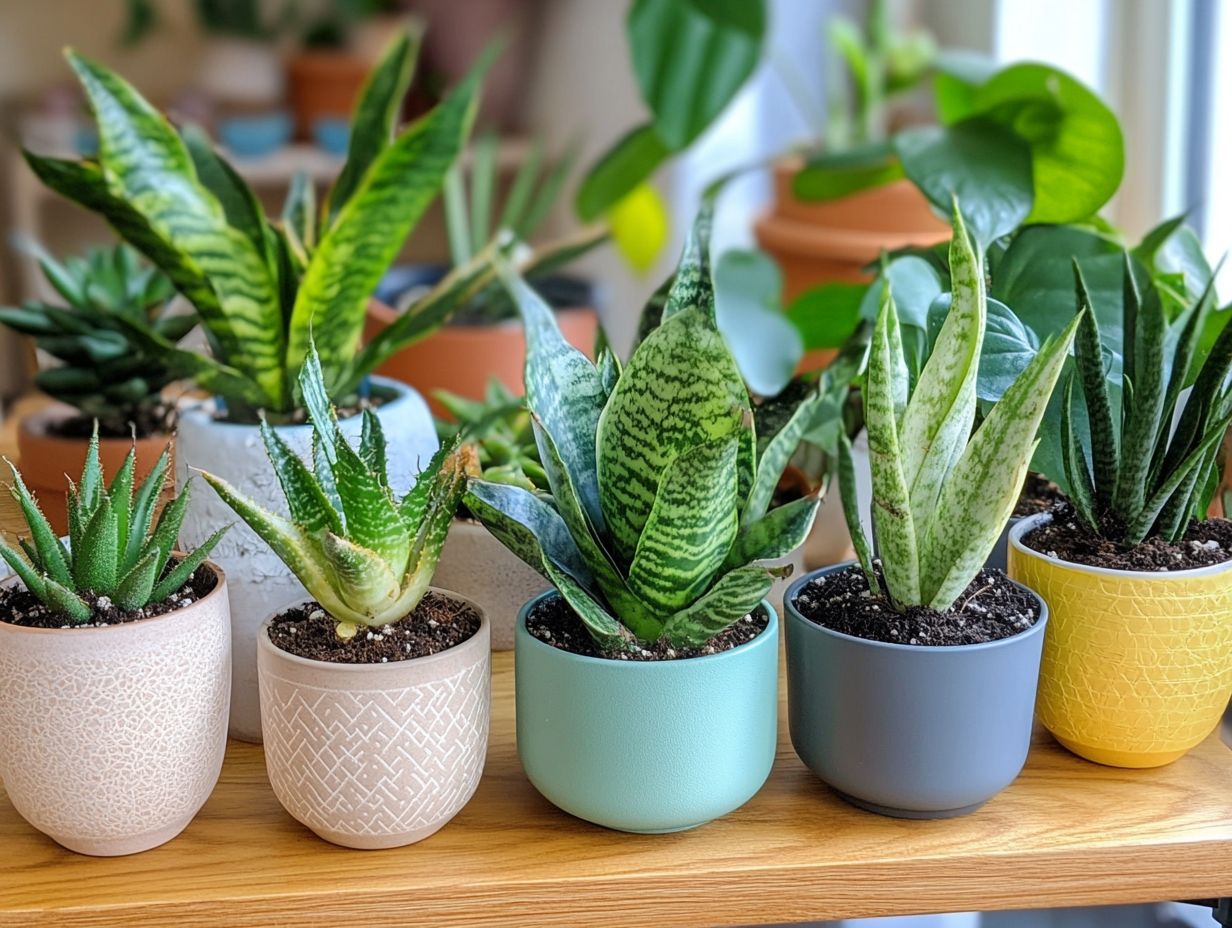
Soil erosion is a significant threat to your gardening and agricultural efforts. Understanding its causes and implementing effective solutions is vital for maintaining sustainable gardening practices.
Several factors contribute to this pressing issue, including water runoff, wind, and improper land management. When topsoil washes away, you risk losing vital nutrients essential for plant health and productivity.
You can take proactive measures to combat erosion by incorporating conservation techniques such as:
- Planting cover crops (plants grown to improve soil health between seasons)
- Using mulch to retain moisture
- Constructing terraces to slow water flow
Employing no-till gardening practices helps maintain soil structure and encourages beneficial microbial activity. By adopting these strategies, you can protect your soil and ensure a thriving ecosystem for your plants.
34. The Benefits of Mulching for Soil Health
Mulching offers a wealth of benefits for your soil health. It helps retain moisture, suppresses pesky weeds, and adds organic matter, all of which contribute to healthier plant growth.
Various types of mulch provide unique benefits tailored to your gardening needs. For example, organic mulches like wood chips, straw, and grass clippings enrich your soil as they decompose and attract beneficial organisms that enhance soil fertility. In contrast, inorganic mulches such as rubber or gravel deliver long-lasting coverage, excelling in moisture retention and weed suppression.
To apply mulch effectively, aim for a 2-4 inch layer around your plants. Ensure it s not too close to the stems to prevent rot. This simple practice can significantly enhance soil health, fostering a thriving garden ecosystem.
35. The Influence of Soil Temperature on Plant Growth
Soil temperature plays a pivotal role in plant growth, and understanding its effects enables you to optimize moisture levels and enhance overall plant health.
When the soil dips too low in temperature, it can stifle root development, making it challenging for your plants to absorb essential nutrients. Conversely, if the soil gets too hot, you risk increased evaporation and nutrient depletion, which isn t ideal for your garden.
To achieve optimal growth, it’s crucial to maintain ideal soil temperatures typically between 65 F and 75 F for most plants. Keep a close eye on soil temperatures! They can make or break your plants success. To manage these temperatures effectively, consider these strategies:
- Use mulches to insulate the soil
- Plant cover crops during off-seasons
- Utilize row covers to shield against extreme conditions
These practices not only foster healthy root systems but also enhance nutrient uptake, allowing your plants to flourish throughout the growing season. By ensuring adequate soil aeration, you can further promote root growth.
36. The Impact of Soil Compaction
Soil compaction can significantly hinder root growth and overall plant vitality. It s essential to recognize its causes and take action to mitigate compaction for a thriving garden.
Several factors contribute to soil compaction, such as heavy foot traffic, the use of bulky machinery, and excessive moisture content. When soil particles become densely packed, air pockets and water infiltration are restricted, making it challenging for your plants to establish deep roots. This limitation stunts their growth, preventing your plants from thriving!
To alleviate compaction, consider strategies like:
- Regular aeration and incorporating organic matter to boost soil health
- Practicing crop rotation
These approaches enhance soil structure, helping it regain its natural porosity, which in turn supports healthier and more vigorous plant growth. Furthermore, utilizing nutrient-rich amendments can dramatically improve your garden’s yield.
37. Adapting Soil Practices for Climate Change
Proactive measures can mitigate environmental impacts. They also ensure your soil stays healthy.
Temperature and rainfall patterns are changing. Understanding soil ecosystems is crucial.
These changes can lead to erosion, nutrient depletion, and increased pest pressure, all of which pose a threat to your garden’s health.
You are encouraged to implement strategies such as:
- Crop rotation
- Cover cropping (planting specific crops to protect and improve soil health)
- The use of organic amendments
These approaches significantly bolster soil resilience. Mulching retains moisture and protects soil structure for optimal plant nutrition.
Embracing these techniques nurtures robust ecosystems. You also contribute to sustainability efforts, ensuring better plant care.
Act now to protect your garden! Implementing these strategies makes a difference.
Frequently Asked Questions
What are the best soil choices for specific indoor plants?
The best soil choices for specific indoor plants depend on the type of plant and its specific needs. Generally, using a high-quality potting mix with good drainage and aeration is recommended for most indoor plants.
What type of soil is best for succulents and cacti?
Succulents and cacti thrive in well-draining soil with good aeration. A combination of potting mix and a small amount of sand or perlite can create the perfect soil for these types of plants.
What is the best soil choice for ferns and other humidity-loving plants?
Ferns and other humidity-loving plants do best in soil that retains moisture well while allowing for proper drainage. A mix of peat moss, potting soil, and sand can provide the perfect balance for these plants.
Can I use regular garden soil for indoor plants?
No, regular garden soil is not suitable for indoor plants as it can be too heavy and compact, leading to poor drainage and aeration. It may also contain pests and diseases that can harm your indoor plants.
What is the best soil for orchids?
Orchids are epiphytes, meaning they naturally grow on other plants and do not require soil to survive. However, for potted orchids, a mix of bark, sphagnum moss, and perlite is recommended for proper drainage and aeration.
How often should I repot my indoor plants?
The frequency of repotting indoor plants depends on their growth and the size of their current pot. Generally, it is recommended to repot every 1-2 years, or when the plant becomes root-bound and starts to outgrow its current pot.

